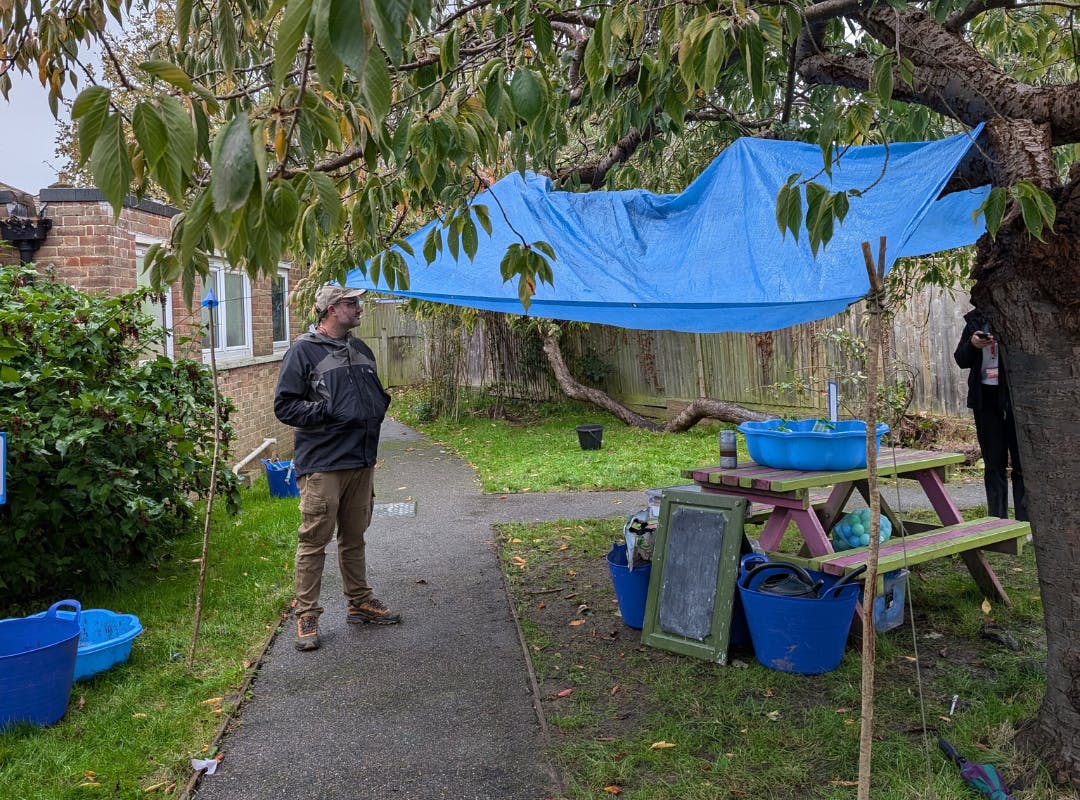Back to news
Wonderous Water Workshop
A day in the life of our Schools Engagement Consultant Nick Couzens and the OurRainwater Team at one of our SUDS for schools' sessions.
What can you expect from one of our workshop days?
"Best day ever" - A group of Year 5 students
- SUDS
- waterbutt
- school
Schedule
In this section we will give a typical timeline for our SUDS for schools projects for teachers to get a sense of what to expect.
Note: The schedule can be adjusted to better fit the schools schedule. Nothing is set in stone.
Up at 0600
We rise early to ensure the van is packed and we have all of our waterproof gear for the day (and that we have eaten enough for the busy day ahead).
Leave at 0700
It's better to be early and late! We like to leave early to beat any morning traffic and find a nearby parking spot for the multiple trips to and from the van.
0800 arrive at school
Upon arrival at the school we provide compliance documents such as an up-to-date DBS certificate and follow the school sign in procedure. Most of the hour is filled with unloading the van and getting everything set up in the designated location.
0900 - Presentation
Nick delivers a short introduction to the topic of flooding and gets the children ready for the day ahead. We can be quite flexible here and combine it with the outdoor intro so as to not clash with morning assembly.
0930 - Outdoor Intro
We lead learners around the various activities and give them an example of how to safely use the various equipment and activities.

Testimonial: "The children had a fantastic day, with so many brilliant activities." - Teacher

0945 - Team Building Task in Two Groups:
Gutter Gulley Galore & Den Building
The class is split into two groups where they each do a task and then swap over halfway through. In Gutter Gulley Galore, bamboo sticks are used to prop up guttering with the goal of directing water into buckets. The den building activity uses sticks to prop up a tarp, fastened by rope. Students then stand underneath the tarp whilst water is poured over the top to see whether they have successfully directed the water away. Nick likes to introduce an element of competition during these tasks!
1030 - break
1045 - Wonderous Water Carousel (Museum Style)
Children explore the activities that best interest them.
In the wonderous water carousel, the children are allowed to peruse each activity for however long they like, there is no requirement for them to do each activity. We monitor the children and help solidify the education these fun activities.
The activities include:
- Slow the Flow - Natural flood management (beavers)
- Archimedes Screw - Engineering moves water uphill - shows how problems can be solved through engineering
- Direct the Flow - Builders and engineers can move water where they want it to go (to protect houses)
- Floating Cities - Engineers will need to get creative to work around climate change
- Super Soil - Different surfaces infiltrate water at different rates.
- Messy Muddy Dam Building - highlights canals and how water can affect the stability of the ground
- Tin Foil Streams - Manage to get water moving where we want it to. Also looking at how rivers can flood their banks at the same time.


Pre-lunch - Deflection & Extension Tasks (Penny and H20)
The children can be quite excitable after the carousel of activities so we have two focused activities to bring down energy levels. The first activity teaches them about the water molecules and how its structure leads to its unique properties. The second activity involves delicately pipetting droplets of water onto a 2p coin showing how the water molecules like to bond together.
Testimonials: "It was a really memorable day for them."
Lunch
A well-deserved break for us and the children.
Explanation and Design Task Post Lunch
The afternoon presentation ties all their learning from the morning together, turning play into educational takeaways. Topics are reintroduced from the morning and applied to each of the tasks they completed.
The rest of the session is to do with the design task, where students design their own sustainable drainage system for their school. Our Rainwater uses these innovative designs to identify opportunities for real-world use at the students school. The design task is important as it allows the children to take ownership of the project and see results at the end of it.


1430 - Clean, Pack Up & Leave
Once this is done, we leave before the end of the day so that the teacher can bring down energy levels before home time and it gives us time to pack the van and leave before parents start arriving.
One thing that's great about these days is that the teachers don't have to plan anything to keep the children engaged or help us out, they can aid us with class behaviour, but all the deliverables are done by us!
Testimonial:
"It was brilliant working with Nick and the students on the project. Nick really engaged with the variety of students using differing techniques to support them and get the best from each one. The student took part willingly in all activities and really had fun with the practical elements. Students in the second group enjoyed finding out facts about the local area and how the landscape has changed.
Nick worked with students one to one when it was needed, this was predominantly when the students were designing water butts. Helping students to foster their ideas and get them on paper."
How do we make sure the workshop day runs smoothly?
Nick's Inventions and Activity Stations
Nick spends a lot of time in his free time making the equipment and stations for the children to use. Our favourite is the concrete river, which has been made on a sloping piece of wood, Nick has concreted the top and allowed there to be a valley-like formation to simulate a riverbed. Before it set Nick placed some twigs in the concrete to simulate trees along the riverbank for the students to visualise. It's also been painted green and blue to aid visual learners in understanding what it represents.
Once set up, the idea is for the children to pour water down the slope and to see how fast it flows. They are then given sticks to pack into the riverbed and dam it up (like beavers) and then pour water down it. The children really do notice how much it slows the flow of the water, and even noticed that if they pour the water slower that the flow downstream is lessened. This really helps to simulate a real-life rainfall event and the practicality of it is perfect for visual learners.


Cleaning the Items Before & After
Nick always ensures to use the water in the buckets and the pools to water any plants or greenery around the school, testing the absorption of the grass more so than the capacity of the drains! Cleaning the mud from all the equipment is no bother, and it essentially becomes compost for the plants. The real issues arise with the clay the children have been using to damn up the water and protect their wooden houses.
The clay has been thoroughly compressed and soaked that by the end it feels stronger than super glue and needs old-fashioned elbow grease to scrape it off. Nick ensures that most of the residue is off but doesn't spend too long cleaning them at the school so that he can give the space back, he does a basic clean and then thoroughly cleans them at home and stores it all in his shed.
Loading Van & Unloading
Loading and unloading the van according to Nick is "an art". Items need to be stacked correctly so that they don't crush one another and rattle around in the van. Loading the van at his house is not usually a bother but at the school there can be difficulties. Most schools are in highly residential areas and therefore are limited on parking. Nick either must park far away and carry the heavy equipment or arrive at the school very early and bring the van down and unload before the children arrive.

Our Set Up Process at the School
The first part of set up includes filling buckets and paddling pools with water (not fully) as this is what takes the longest. Then comes all the information boards on stands so the children can learn whilst moving from task to task. Then comes preparing all the clay and soil for the dam building and messy mud exercises, which is by far the messiest job. Then comes the infiltration task, slow the flow and Archimedes screw which need to be spaced evenly to give the children plenty of room. Lastly is setting up the sticks, tarps and guttering for the two main tasks of den building and gutter gulley galore. There are many more smaller tasks which we have not mentioned but thought it best to show a general overview of the main ones.
Our Commitment to Compliance, Safety, and Communication
When working in school settings, we understand that safeguarding and clear communication are essential to maintaining a safe and productive environment. Each step of our process is designed to uphold the highest standards of safety ensuring that schools, students, and staff feel fully supported throughout our visit.
1. Comprehensive DBS Checks for All Team Members
Safety is our top priority. Members of our team undergo a thorough Disclosure and Barring Service (DBS) check, ensuring they meet all the necessary legal and ethical requirements to work safely with children and young people. If our team are attending with a member without a DBS check, that employee will be with a DBS checked employee or teacher at all times. We update and monitor our DBS records regularly, providing schools with peace of mind regarding the people we bring onto their premises.


2. Rigorous Risk Assessments for Every Activity
We conduct detailed risk assessments ahead of each school visit, analysing every element of our planned activities to identify and mitigate any potential hazards. This process ensures that every interaction, space, and activity meets our strict safety criteria, helping to protect students, staff, and our team from avoidable risks. We proactively address concerns, allowing us to adapt to the unique needs and layouts of each school to provide a secure experience.
3. Responsive Communication Before and After the Visit
Effective communication is the cornerstone of a successful partnership. In the lead-up to our visit, we keep schools updated on our plans, schedule, and any necessary preparations. By addressing questions and requests promptly, we make sure everyone is fully informed and confident in our process. After each visit, we remain readily available for any follow-up questions, ensuring a seamless experience from start to finish.


4. Detailed Follow-Up Report for Transparency and Improvement
Once the day’s activities conclude, we compile a comprehensive follow-up report for each school. This report includes a summary of the day, observations, any incident logs (if applicable), and reflections on what worked well, along with any areas for improvement. This document serves as a transparent record and provides actionable insights that we can use to continually refine our approach to meet each school’s unique needs.
Through these measures, we demonstrate our dedication to creating a safe, well-coordinated, and valuable experience for everyone involved. We believe that careful planning, rigorous standards, and open communication are essential to the work we do with schools, helping us build trusted, long-term partnerships.